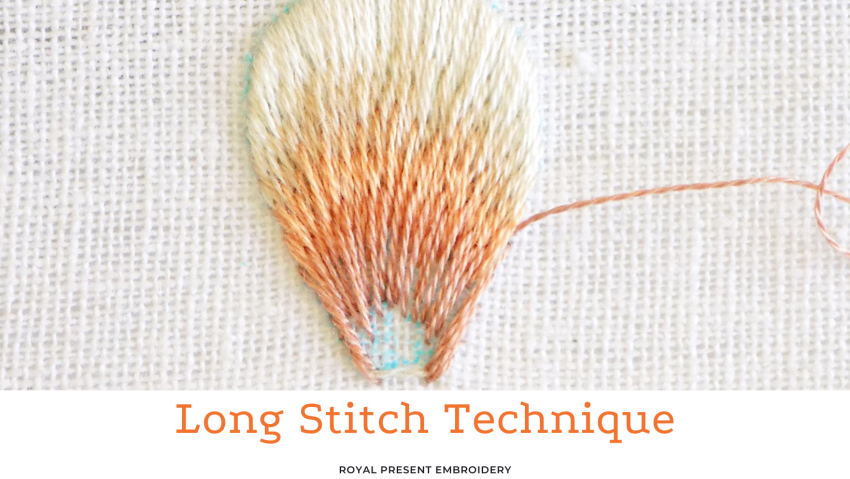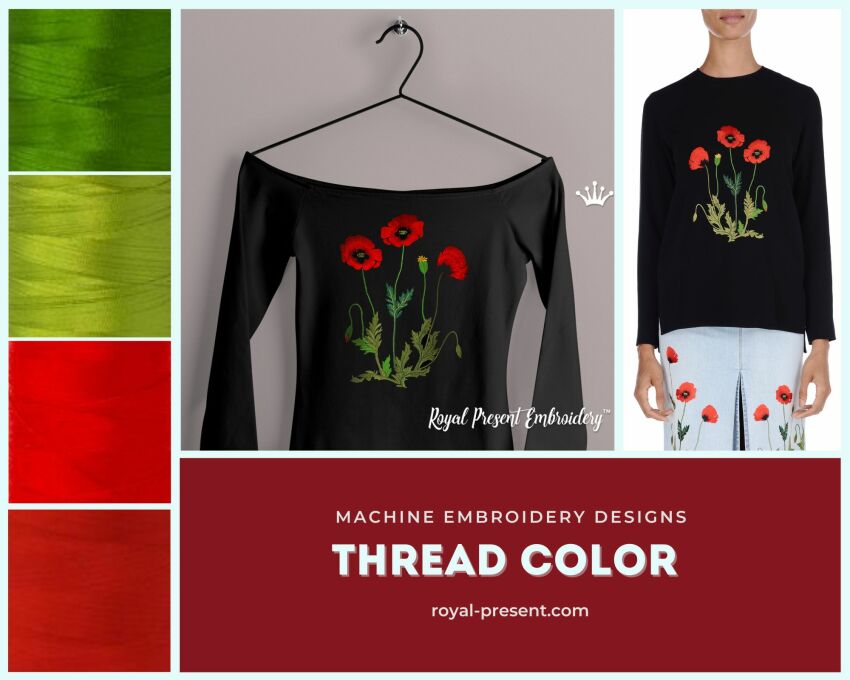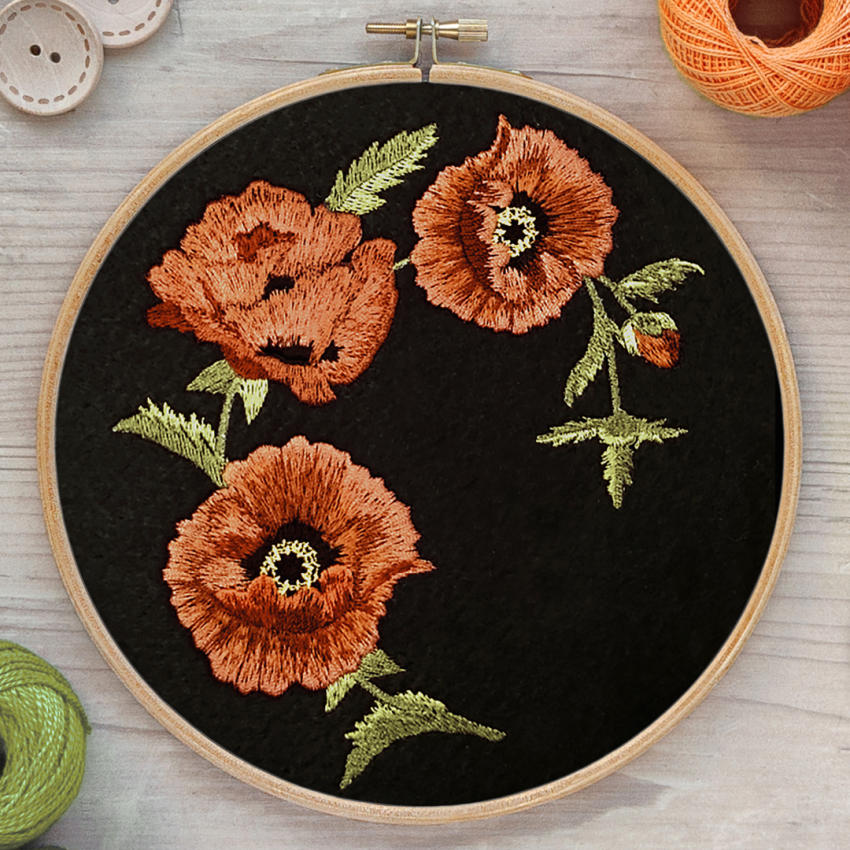
Hand embroidery of poppies with silk threads
In this fascinating article, we explore the fascinating world where artistry and technology intertwine as the art of machine embroidery breathes life into the embroidered poppy. Step into a realm where intricate designs and delicate threads combine with the precision and capabilities of modern machines, giving rise to stunning creations that honour the timeless symbol of the poppy.
Discover the incredible craftsmanship behind machine embroidery as we delve into the techniques, tools, and creative processes skilled artisans employ. From selecting the perfect thread colours to programming complex patterns, we uncover the meticulous attention to detail required to bring the embroidered poppy to life.
Join us on a journey through the rich history of embroidery, where traditional hand-stitched techniques find a harmonious partnership with cutting-edge technology. Witness the evolution of this ancient art form as it embraces the capabilities of modern machines, enabling artists to create intricate, lifelike renditions of the beloved poppy.
Discover how machine embroidery has transcended traditional boundaries, finding its place in various creative disciplines, including fashion, home decor, and artistic installations. Uncover the versatility of this medium as it breathes new life into the embroidered poppy, transforming it into a symbol of inspiration, remembrance, and artistic mastery.
Whether you're an embroidery enthusiast, an art lover, or simply curious about the intersection of technology and craftsmanship, this article will transport you into the captivating realm where the art of machine embroidery breathes life into the embroidered poppy. Prepare to be amazed by the intricate beauty and boundless possibilities that arise when tradition and innovation unite.
Poppies Wreath Machine Embroidery Design
Long Stitch Technique with Poppies Wreath Machine Embroidery Design
When discussing the long stitch method in hand embroidery, it's important to note that the length of the stitch varies, typically around 1 cm (0.4"). However, machine embroidery has its unique characteristics. In particular, mid-range embroidery machines generally have a stitch length of 0.7 cm (0.3"). Therefore, when creating designs using this technique, it's necessary to consider the machine's capabilities.
When digitizing designs, we also take into account the depth of one stitch penetrating another.
Take a look at this example of stitching similar patterns in hand embroidery.

Notice how each stitch flows seamlessly without overlapping and creating a bulky appearance. This embroidery technique allows the stitches to blend smoothly, creating a delicate yet cohesive design. The stitches are not overly dense but precisely placed to fit perfectly.
Digitization is a highly intricate and time-consuming process that requires a great deal of expertise. Only those with the long stitch technique skill to embroider such works by hand can excel at digitization. Our expert digitizers not only have a mastery of digitization techniques, but they are also skilled in hand embroidery.
Here's what you should keep in mind before embroidering a similar Long Stitch design.
Mastering Stabilization Techniques for Flawless Long-Stitch Embroidery
Understanding the Challenge:
Long-stitch designs, with their elongated stitches, place additional strain on the fabric. Without proper stabilization, the fabric may pucker or distort, compromising the overall quality of the embroidery. To combat these challenges, follow these essential guidelines:
1. Select Dense Fabrics: Choose fabrics with a sturdy and dense composition, as they are better equipped to handle the tension imposed by long stitches. Fabrics such as denim, canvas, or heavy cotton are ideal, providing a solid foundation for your embroidery.
2. Embrace Cutaway Stabilizer: The cutaway stabilizer is often the preferred option when stabilising long-stitch designs. The cutaway stabilizer offers long-lasting support and prevents the fabric from distorting or stretching during embroidery. A choice is to utilize a tear-away stabilizer. Remember that the outcome depends on the fabric's thickness and the stabilizer used.
Now that we understand the importance of stabilization let's explore the step-by-step process of stabilizing long-stitch designs:
1. Hoop the Fabric and Stabilizer Together: Begin by placing a piece of cutaway stabilizer larger than your hoop's size on the back of your fabric. Position the fabric and stabilizer in the embroidery hoop, ensuring they are taut but not excessively stretched.
2. Secure the Hoop: Tighten the hoop's screws to hold the fabric and stabilizer securely. The tautness of the material should be evenly distributed, without any wrinkles or loose areas.
3. Trim Excess Stabilizer: Trim away the excess stabilizer from the back of the hoop, leaving a small margin around the embroidery area. This ensures that only the necessary stabilizer remains, reducing bulk and allowing the fabric to retain its natural drape.
4. Embroider with Confidence: Once you have firmly secured the fabric and stabilizer in the hoop, you can proceed with embroidering your long-stitch design. The stabilizer's primary function is to support the fabric, preventing it from tightening excessively and ensuring that stitches are smooth and even.
5. Our suggestion is to decrease the speed of your embroidery machine.
As you venture into the world of long-stitch embroidery, remember that stability is paramount for achieving impeccable results. By carefully selecting dense fabrics, such as denim or heavy cotton, and embracing cutaway stabilizer, you can effectively combat the strain caused by long stitches. Invest in quality stabilizers and incorporate them seamlessly into your embroidery process, allowing your fabric to retain its integrity and ensuring the longevity of your stunning long-stitch creations. With proper stabilization techniques, you can confidently embark on your embroidery journey, knowing that your fabric and stitches will harmoniously come together to form enduring works of art.
Top Brands Offering Cutaway Stabilizers for Machine Embroidery
- Sulky
- Madeira
- Floriani
- Pellon
- OESD (OESD Stabilizers)
- Vilene
- Brother (Brother Stabilizers)
- Gunold
- Hatch (Hatch Embroidery Stabilizers)
- Inspira (Inspira Stabilizers)
Mastering the Art of Thread Color Selection in Long Stitch Embroidery
Embroidered poppy in extended stitch technique is a beautiful addition to any fabric, but choosing the right thread colours can be daunting. The selection of colours can completely change the look and feel of the finished product. There are numerous factors to consider when deciding on thread colours, such as the type of fabric, the design, and the intended use.
When creating embroidered poppy, your chosen colours can significantly affect the outcome. If you aim for a sophisticated and refined look, incorporating shades of red and pink can create a beautiful and whimsical effect for the poppy design.
Having enough thread colours for your projects can be challenging. However, to create stunning poppy designs, it's essential to have a minimum of three shades of green and red threads closely matched in colour and tone. These colours in your thread will ensure your embroidered poppies look their best.

Red Poppies Machine Embroidery Design
Leading Brands Providing Threads for Machine Embroidery
Madeira
Robison-Anton
Brother (Brother Embroidery Threads)
Isacord
Floriani
Gutermann
Sulky
Mettler
Marathon
Hemingworth
Extra Services
On our website, especially for you, we have made a converter of Madeira threads to other palettes. Not everyone has Madeira embroidery threads; many use threads from other manufacturers. Especially for your convenience, we have made this converter. Knowing the Madeira thread colour number, you can easily find the thread shade you need from your palette. Check this link, please Madeira Thread Free Exchange converter online
In conclusion, selecting the right thread colours for embroidered poppy and long stitch designs requires careful consideration of various factors. Every element plays a role in the final product, from the type of fabric to the intended use and the design itself. A sophisticated and refined look can be achieved through high-contrast colours, or a whimsical effect can be created using different shades of the same color. Whatever your design goals, carefully selecting thread colours will help make your embroidered poppy and long-stitch designs stand out.

Author: Ludmila Konovalova
My name is Ludmila Konovalova, and I lead Royal Present Embroidery. Embroidery for me is more than a profession; it is a legacy of my Ukrainian and Bulgarian heritage, where every woman in my family was a virtuoso in cross-stitch and smooth stitching. This art, passed down through generations, is part of my soul and a symbol of national pride.
Date: 29.06.2023




 Get Sign-In Link
Get Sign-In Link Login with Google
Login with Google Login with Facebook
Login with Facebook Login with Amazon
Login with Amazon Login with Paypal
Login with Paypal